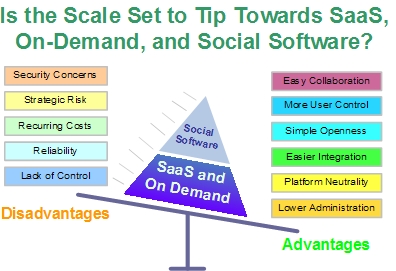Web-based software: Not for prime-time yet?

I read with interest the recent CNet interview with SAP CEO Henning Kagermann where he was asked more questions about on-demand software and social software than not. Kagermann isn't overly impressed with the on-demand model and crisply defends what SAP, one of the largest software companies in the world, is doing with their hybrid model. He makes the point that their customers run their core businesses on SAP and would be out of business if their SAP implementation goes down.Small systems cannot tolerate long, continuous contact with much larger systems without being changed fundamentally. This is all said of course during the backdrop of the recent Web browser patches which shut down many Web-based apps, business and otherwise, until workarounds were deployed.
Is this another case of shiny new technologies like Ajax and SaaS wagging the dog and getting all the good press? A lot of folks would say so certainly, but the truth is more complex. For one, Fred Wilson pointed out a few days ago that the adoption of this latest wave of software is flowing in reverse, and seems to be driven more from the consumer to the workplace than from the workplace to consumer. Thus innovation is coming from an unexpected direction.
And then there's the strong tendency for leading edge trends not to be followed initially by larger, slower moving enterprises. The leading edge is increasingly followed by small to medium size businesses (SMBs), particularly since they're one of the last significant growth areas in software.
And it's this place where things start to get interesting. A key aspect of Web 2.0 software is customer self-service. And not just in your ordinary, give them a Web-form to fill out and let them go about their way, but real mechanisms to let customers help themselves to what they need to do with your organization. Providing rich online services, often as real Web services, are allowing companies to turn over more control to their customers on the Web, allowing to serve smaller and more niche customers than ever before (real examples near the bottom of this previous post.) For Web 2.0 followers, this phenomenon is sometimes called the The Long Tail.
OK, so looking past the piece where enterprises can reorient their customer facing sides with online software. Will Software as a Service (SaaS), social software (blogs, wikis, social communities) really make inroads in the enterprise any time soon? If the world was a fair place, the answer would be driven by a real, honest-to-goodness comparison of advantages and disadvantages.

So let's take Ajax for example. Ajax is an amazing technique for SaaS front-ends; it works in almost any browser you can find, requires no administrator rights, no installation, and the GUIs for it are getting truly amazing. And Ajax even prefers genuine Web services to communicate with, making lighterweight SOAs your friend instead of your albatross. But Ajax development skills are still few and far between, Ajax applications don't work during network hiccups, and there is no storage of information locally (at least without serious hacks.)
OK, but how about blogs and wikis? Don't they offer terrific opportunites for people to provide self-service IT and set up ad hoc knowledge bases and communities? Yes, but SAP's Kagermann also dismisses them as too unstructured to do "real" office work. You must have structure and order to get important business done according to the CEO of one of the world's most influential business software companies. And while that's no doubt true in many applications, other influential folks might tend to disagree. For example Harvard's Andrew McAfee recently wrote:
One of the main [reasons that previous online encylopedias went to] Wikipedia was a huge reduction in the amount of structure in the content creation and editing process. The structure was intended to act as a barrier to bad content, but instead it acted as a barrier to all types of content, and to broad participation. [The italics are McAfee's]
So where does that leave us? Well, it leaves us wanting more information really. The intellectual appeal of SaaS, On-Demand, and social software might seem clear for a lot of reasons, but often fails to charm the more that one ascends to the heights of enterprise. Security, reliability, control, and cost all become enormous issues at such scale.
But, if you look at the adoption of these very same things out on the Web, for example Technorati's Sifry just reported that the entire global blogosphere has just doubled, again, to over 35 million blogs, and MySpace continues to fly off the charts, you'll see that something truly momentous is happening. Even if you look at it in the terms of the raw online social habits that are developing, much less expectations that both customers and employees will have in the near future when using software, and it seems a little more clear that the concept of software itself is being recast and becoming intractably linked to the Web.
Is the real risk in not risking it?
So let's face it, the real risk is more in fundamental disruption; as in not being familiar or experienced with the technologies, social forces, and expectations that are being developed right now by tens, no, hundreds of millions of people. The IT world of the future is a dramatically different place, just like it was ten years ago, or twenty years ago. What it will look like is almost certainly a lot of what we see on the Web today.
We should also remember that small systems (which enterprises are, when compared to the Web) cannot tolerate long, continuous contact with much larger systems without being changed fundamentally. Change for the positive should be the goal, and along with it, hurdling the risk of disruption. So, get your crystal ball out, we all have some tricky forecasts to make.
Is the tipping point for SaaS, on-demand, and social software nigh, inside the enterprise?